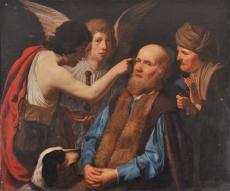


This work, rather large for a 17th-century Dutch painting, portrays an episode in the life of Tobias, son of Tobit, as told in the apocryphal Old Testament Book of Tobit. The aging Tobit is shown being cured of his blindness by Tobias, as told in Tobit 11:11-15. This text relates how the young Tobias returned home from a long journey to collect a debt for Tobit and was greeted by his blind father, who stumbled on his way to the door. Tobias took hold of him and immediately applied fish gall to his eyes, causing the white film that obscured his vision to fall away, thereby restoring his sight. It is the climactic moment of the Book of Tobit.
In Portengen’s depiction we see the old Tobit seated in the middle. Behind him is his wife, Anna, and young Tobias is on the left, applying the fish gall to his father’s eyes with his right hand. The mortar and pestle which he had used to crush the gall is in his left hand. Tobias is still wearing his travelling clothes, with a bag on his side. His dog, mentioned in the texts, is also present, while in the background we see a young man with wings, the Archangel Raphael. It was this angel who had accompanied Tobias on his long journey, offering him constant divine assistance along the way and seeing him safely back home. However, he had played the role of companion in disguise, namely, as the helpful kinsman Azarius. It is only at the end of the story that Raphael revealed himself as an angel. It was Raphael who instructed Tobias to cull the gall from a jumping fish which had surprised Tobias during the trip. Portengen arranged his composition in isocephaly, with all the heads at the same level.
The Book of Tobit was very popular in Holland in the 17th century, especially in the circle of Rembrandt and his many pupils and followers. In their works, we always see the story depicted in a clearly defined interior. Portengen, however, has chosen to depict his protagonists in an undefined space as life-size half figures. This idiom derived from the Utrecht followers of Caravaggio, who almost always portrayed half figures in a strong light in their works from the 1620s. Gerard van Honthorst, Hendrick ter Brugghen, Dirck van Baburen and Jan van Bijlert, the best of the so-called Utrecht Caravaggisti, all made their paintings in this style, which clearly provided Lumen Portengen with a model. However, the story of the healing of Tobit was, as far as we know, never represented by these townsmen of Portengen. It therefore looks as if the artist had taken the popular story from Rembrandt and his followers, but presented it in the manner of the Caravaggisti, the circle of artists to whom Portengen must also be associated.
Portengen was born in 1608 in Utrecht, the son of well-to-do Catholic parents. He had a younger brother, Roetert, and a cousin Petrus, who also became painters. Lumen and Roetert seem to have practised their profession as amateurs only. Lumen was the most versatile of the three Portengens, butjust like his brother and cousin he cannot be ranked among the best artists in their family. Nevertheless, Lumen had studied for a year and a half in Rome, but where he had received his initial training is not known. In recognition of his time in Italy he once signed a notarial deed in Utrecht with ‘Lumo’ instead of Lumen. In 1637 he donated a Sleeping Venus to the Utrecht hospital, the Sint Jobs Gasthuis, while from a year earlier dates a Bearded Lute Player in the Centraal Museum in Utrecht. A Musical Company with Five Figures in the Musée de Tessé in Le Mans dates from 1643. The Healing of Tobit is also dated, though the last digit is, unfortunately, no longer legible. Nevertheless, it is clear that it must have been painted between 1636 and 1639. It was Willem van de Watering, who, on the basis of the stylistic quality, placed this work in the oeuvre of Lumen Portengen, an attribution that was, however, not shared by the British art historian and connoisseur Benedict Nicolson. Van de Watering made this attribution on the basis of a photograph of the painting, on which he could decipher a signature and date. The picture was offered for sale in 1967 in Versailles as ‘Portenjen’ without further specifications or any indication of a signature and remained unsold.
The same auctioneer offered the painting again three months later, now under the self-made name and attribution, ‘Attribué à Van Hoorst’, where it was acquired by A. G. Leventis. Nevertheless, van de Watering was right in his determination. If we compare, for example, the facial type of the Archangel Raphael with that of the young violin player on the extreme right in a Musical Company with Six Figures, then it is clear that this is the work of one and the same artist. This facial type can also be seen on the young man playing a contrabass on the extreme right of the Le Mans Musical Company. Also, the facial type of old Tobit with a beard can be found in other works by Lumen Portengen, such as the Bearded Lute Player in Utrecht and King David Playing the Harp, which was once with the art dealer Caretto in Turin.
Van de Watering sketched an image of Lumen Portengen as an artist who probably painted more in his leisure than to make a living, given his wellto- do background. Nevertheless, The Healing of Tobit is an interesting painting by a rare Utrecht Caravaggist master, who has earned a certain place in the literature.
He came from a well-off family in Utrecht and painted in his leisure, having had some initial training and a stay in Italy. His style derived from that of the early- to mid-17th-century Utrecht followers of Caravaggio.